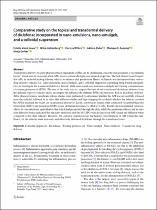| dc.contributor.author | Dube, Admire | |
| dc.contributor.author | Louw, Estelle-Vionè | |
| dc.contributor.author | Liebenberg, Wilna | |
| dc.date.accessioned | 2024-01-26T08:03:07Z | |
| dc.date.available | 2024-01-26T08:03:07Z | |
| dc.date.issued | 2022 | |
| dc.identifier.citation | Louw, E.V., Liebenberg, W., Willers, C., Dube, A., Aucamp, M.E. and Gerber, M., 2023. Comparative study on the topical and transdermal delivery of diclofenac incorporated in nano-emulsions, nano-emulgels, and a colloidal suspension. Drug Delivery and Translational Research, 13(5), pp.1372-1389. | en_US |
| dc.identifier.issn | 2190393X | |
| dc.identifier.uri | http://hdl.handle.net/10566/9271 | |
| dc.description.abstract | Transdermal delivery of active pharmaceutical ingredients (APIs) can be challenging, since the skin possesses a rate-limiting barrier, which may be overcome when APIs possess certain ideal physicochemical properties. The lack thereof would require that APIs be included in drug delivery vehicles to enhance skin permeation. Hence, diclofenac was incorporated into various drug delivery vehicles (i.e., nano-emulsions, nano-emulgels, and a colloidal suspension containing drug-loaded nanoparticles) to investigate the transdermal delivery thereof, while nano-emulsions and nano-emulgels had varying concentrations of evening primrose oil (EPO). The aim of the study was to compare the topical and transdermal diclofenac delivery from the different types of vehicles and to investigate the influence the different EPO concentrations had on diclofenac delivery. After characterization, membrane release studies were performed (to determine whether the API was successfully released from the vehicle) followed by in vitro skin diffusion studies and tape stripping (to establish whether the vehicles assisted the API in reaching the target site (transdermal delivery)). Lastly, cytotoxicity studies were conducted via methyl thiazolyl tetrazolium (MTT) and neutral red (NR) assays on human keratinocyte (HaCaT) cells. Results showed minimal cytotoxic effects at concentrations equivalent to that which had permeated through the skin, while the membrane release and in vitro skin diffusion studies indicated that the nano-emulsions and the 10% EPO vehicles increased API release and diffusion when compared to the other vehicles. However, the colloidal suspension had the highest concentrations of API within the skin. Hence, all the vehicles were non-toxic and effectively delivered diclofenac through the transdermal route. | en_US |
| dc.language.iso | en | en_US |
| dc.publisher | Springer | en_US |
| dc.subject | Colloidal suspension | en_US |
| dc.subject | Diclofenac | en_US |
| dc.subject | Evening primrose oil | en_US |
| dc.subject | Nano-emulgel | en_US |
| dc.subject | Nano-emulsion | en_US |
| dc.title | Comparative study on the topical and transdermal delivery of diclofenac incorporated in nano-emulsions, nano-emulgels, and a colloidal suspension | en_US |
| dc.type | Article | en_US |

